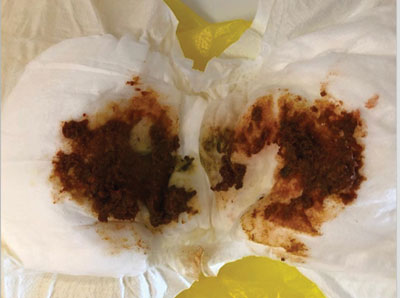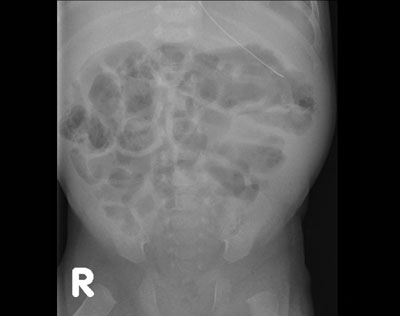Quiz: Haematochezia in a preterm neonate
ST5 Paediatrics, tayyabayasmeen@nhs.net
Raju Sunderasan
Consultant Neonatologist
Neonatal unit, Ayrshire Maternity Unit, University Crosshouse Hospital, Kilmarnock, Scotland
A baby girl (twin 1) was born at 30+2 weeks’ gestation with a birth weight of 1.32kg by caesarean section. She was born in good condition and received vitamin K at birth. She had a stable initial course and quickly established full enteral feeds by the third day of life. As her mother was unable to sustain her milk supply, formula milk was introduced on an incremental basis from day nine of life.
Her stay in the neonatal unit was uneventful until three weeks of age when she was noted to be pale and jaundiced. She was given a top-up blood transfusion as her haemoglobin had dropped from 134g/L to 72g/L over a period of one week. Her platelets, Coombs test, coagulation screen and cranial ultrasound were normal.
At four weeks, she passed bright red coloured stools (haematochezia, FIGURE 1). Her clinical examination was unremarkable apart from mild distension of her abdomen.

FIGURE 1 Blood stained stool in nappy.
1. Which of the following investigations should be performed at this stage?
- Coagulation profile
- Full blood count
- Sepsis screen: C-reactive protein, blood cultures
- Abdominal X-ray
- All of the above

FIGURE 2 An abdominal X-ray.
2. What are the findings on her abdominal X-ray (FIGURE 2)?
- Intramural gas
- Gas in portal vein
- Football sign
- Dilated featureless bowel loops
- Pneumoperitoneum
3. What could be the cause(s) of her haematochezia?
- Necrotising enterocolitis
- Meckel’s diverticulum
- Cows’ milk protein intolerance
- Late-onset haemorrhagic disease of the newborn
- All of the above
4. What should be the immediate management? (choose all that apply)
- Continue feeds
- Nil by mouth and nasogastric tube on free drainage
- Transfuse fresh frozen plasma
- Start empirical antibiotics
Scroll down for the answers
1. The correct answer is (e)
Signs of abdominal distension with blood in stools points towards a serious illness in a preterm neonate. The baby should be immediately investigated with blood tests and abdominal X-ray to rule out necrotising enterocolitis (NEC) and sepsis. It would be reasonable to perform a coagulation screen as haemorrhagic disease of the newborn or any coagulopathy may present with bloody stools.
2. The correct answer is (a) and (d)
There are dilated featureless bowel loops especially in the right upper quadrant with a suspicion of intramural gas (pneumatosis intestinalis). Other findings suggestive of NEC would include fixed bowel loop on serial X-rays, gas in portal vein and pneumoperitoneum.
3. The correct answer is (a), (b) and (c)
All of the given conditions can present with blood in stools. As discussed previously, NEC is a serious disease that affects the bowel of premature neonates in the first few weeks of life. Numerous studies have shown that breast milk is protective against NEC. Meckel’s diverticulum, although rare in this age group, could present with bowel obstruction and painless bloody stools. The incidence and clinical manifestations of cows’ milk protein intolerance (CMPI) in preterm neonates remains poorly understood. Symptoms usually start with introduction of formula milk, however they can sometimes present even in breastfeeding infants due to exposure to cows’ milk protein in breast milk due to maternal consumption. The symptoms of CMPI are rather variable and include diarrhoea with/without blood, constipation, vomiting, rash, increased irritability and failure to thrive. The index case had overlapping symptoms consis-tent with both NEC and CMPI. She was initially managed conservatively for NEC and later commenced on hydrolysed formula milk as her symptoms recurred on trial of cows’ milk. Haemorrhagic disease of the newborn at three weeks of life is more common in babies who do not receive vitamin K at birth, which makes it a less likely cause in this case.
4. The correct answer is (b) and (d)
With these symptoms in a preterm baby, management should involve treating as NEC. Enteral feeds should be stopped with nasogastric tube on free drainage, screen for sepsis, start parenteral nutrition and antibiotics. Giving formula milk or increasing feeds is contraindicated in this situation.
Or read this article in our
Tablet/iPad edition


